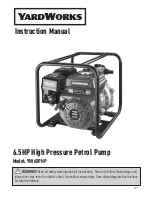
6
Form No. 253585 Rev.
04/19
PVR1 PUMP REPAIR PROCEDURES
DISASSEMBLY PROCEDURE
NOTE: Disassembling the pump to
change components, or for any other
reason, may void the warranty. Refer to
Policy Statement and Discounts
Summaries.
Disconnect all power before disassembly!
1. Remove the key (22) in the rotor shaft keyway.
2. Remove the four cover bolts and slide the cover
back far enough on the shaft to break the seal
between the housing and cover to allow the pump to
drain. A small amount of oil may remain in the pump.
3. Remove the cover (2). Take care to avoid damage
to the bearing with the end of the shaft when the
cover is removed.
4. The thrust plate (5) may come out with the cover.
Do not let it drop off the locating pins.
5. Remove the vanes (7) with a long nosed pliers or
tweezers, there is one vane in each slot, 13 vanes
total.
6. Remove the rotorshaft (3) from the pump. Be sure
that the key (22) has been removed from the keyway
so that it will not damage the shaft seals when the
rotorshaft is removed.
7. Turn the pressure adjustment screw (30)
counterclockwise to release the tension on the
governor spring.
8. Remove the pressure ring (6), ring shoe (11),
governor spring (9), spring seat (8) and follower
spring (10).
9. If the lip seals (24) are to be removed they should
be pushed out from the inside of the housing at this
time. Care must be taken not to damage the bearing
bushing (21) in the housing while the lip seals are
being removed. It is recommended that the lip seals
be replaced whenever the pump is disassembled for
maintenance. The seals cannot be reused once they
have been removed.
10. The bearing bushing (21) in the pumps are
assembled with a press fit. If they are to be removed
at this time, the bearing in the housing should be
pressed out from the front. The cover bearing should
be pulled out using an expanding type puller. The
bearings should not be reused once they have been
removed.
11. It is unlikely that further disassembly will be
necessary in order to perform routine maintenance on
the pump.
REASSEMBLY PROCEDURE
1. Clean and inspect parts to determine which parts
are worn enough to require replacement.
2. Assemble the new bearings (21) in the housing
and cover. The bearing OD's should be lubricated
before they are pressed in the bores. Care must be
taken to orient the "split" and the "oil groove" in the
bearing as shown in the illustration below.
3. After the bearings are in place, check to see that
the rotor shaft (3) will fit into the bearings and provide
a smooth turning fit. If the shaft turns hard, the
bearings should be removed and the bore checked
closely for nicks or burrs before pressing in the new
bearings.
4. Check all of the replacement parts for nicks or
burrs and then lubricate them with clean oil before
reassembly.
5. Worn port (4) and thrust plates (5) should not be
reground to clean up the wear surface. If the plates
are ground, the assembly clearance will become
excessive and the seal rings in the thrust plate may
rupture. Replace worn port and thrust plates if
necessary.
6. Assemble the port plate (4) on the locating pins
(23) in the body housing. If the bores are not
concentric, the port plate must be rotated 180° on the
locating pins.
7. Assemble the springs (9 and 10), spring seat (8)
and ring shoe (11), pressure ring (6) and rotorshaft
(3).
8. To assure proper vane assembly, place the vanes
(7) with the beveled edge against the pressure ring.


























